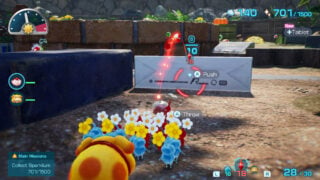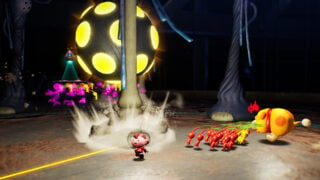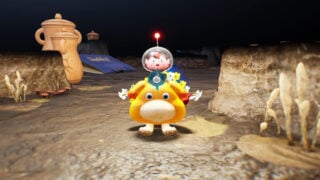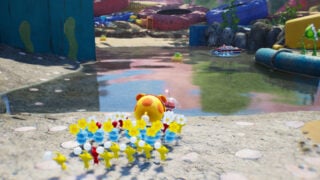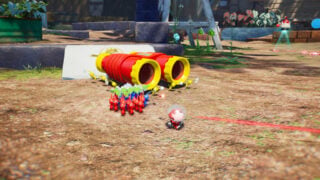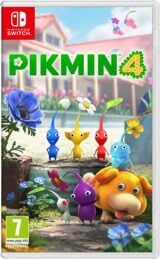Review: Pikmin 4 is a brilliant entry point for new players, but takes a while to bloom
Veterans have to get through a familiar start to reach the best of what’s on offer
- Chief director
- Yuji Kando
- Key Credits
- Tetsushi Tsunoda (Director), Daisuke Warashina (Associate director)

Pikmin 4 is a smart and content-packed refinement of one of Nintendo’s most underrated series, but long-time fans may be put off by how long its generous campaign takes to get going.
Nintendo claims the Nintendo Switch instalment has been built as an ideal entry point for newcomers to the series – and in that, it’s absolutely succeeded. For first time players, this may be Pikmin’s greatest standalone entry, but for veterans, there’s also quite a lot of repetition to get through until its best content sprouts and blooms.
Previous Pikmin games offered frequently demanding strategy gameplay, where every second not spent micromanaging your six different species of Pikmin – and later, other squadmates too – marched you closer to sundown, when everyone left unaccounted for would be munched by giant bugs.
There’s no denying that previous entries were not particularly accessible, which is likely why the series has never sold amazingly well. However, fans will be glad to learn that the myriad tweaks Nintendo has made in Pikmin 4 are subtle and carefully considered.
Pikmin 4 Onion Locations
Purple Online location | White Onion location | Ice Onion Location | Rock Onion Location | Pink Onion Location
Controls now subtly lock-on to enemies, and the camera is zoomed much closer to the action, but otherwise you’ll still spend the opening 15-or-so-hours following the conventions of the previous games; collecting treasure, growing more Pikmin and fighting enemies during a day cycle which ends at sundown.
There’s no overbearing 30-day time limit or food supply like in earlier games, but the most challenging content is still there, walled off from the main story, which makes for a less stressful experience overall.
The game starts with Captain Olimar, the hero from the original games, yet again crash-landing on a strange planet, which is the home of the Pikmin, an obedient, plant-like race who love nothing more than lifting heavy objects and fighting giant monsters for alien visitors.
A rescue team is dispatched to rescue Olimar, but of course, they end up crash-landing on the planet too. As a rookie, it’s now up to you to explore the surface, find your missing space crew, as well as the treasure required to repair your ship and solve the mystery of what happened to Olimar.
Structurally, Nintendo has made welcome changes. This time, players get to create their own rookie character from scratch, and there’s even a hub area where any crew members you rescue will appear, allowing players to chat to them, access their various features (such as a creature database), and complete achievements. For a series where previously, players spent a lot of time alone, this feels like a big departure, but a welcome one.
You’ll also no doubt have noticed that players now have a dog: Oatchi will join players on their adventure and can be commanded to smash obstacles, transport heavy objects and carry Pikmin on his back, allowing you to traverse dangerous waterways or jump to small ledges.
Perhaps his most impactful abilities, though, incorporate some of the squad gameplay from the previous game: players can use a quick menu to order Oatchi to sniff out treasure or stranded crewmates, and you can also order him to parts of the environment using your mini-map.
Players can switch and command Oatchi directly at any time, allowing you to perform tasks such as activating a switch, while at the same time, your character progresses via another route with Pikmin in tow. So if you want, you can use Oatchi just like a super-strong Pikmin, but advanced players will find he’s far more useful as an AI squadmate.
“If you want, you can use Oatchi just like a super-strong Pikmin, but advanced players will find he’s far more useful as an AI squadmate.”
More significant alterations have been made to the overall objectives and economy of the game. In earlier entries, players had to recover ship parts or food. In Pikmin 4, there a few different types of collectable; treasure is converted into fuel for your ship, eventually unlocking new areas to explore.
In terms of resources, collecting pellets and taking them to your Onion will again grow more Pikmin, but at the start of the game, you’re now limited to just 20 who can be out on the field simultaneously. In order to increase this, you’ll need to find a new item called Flarlic Bulbs, which will increase the number of Pikmin you can take out by 10.
Meanwhile, Raw Material is a new resource found in the game world which Pikmin can return to your ship. This can then be used to repair bridges, climbing walls and the like during your explorations, but also as a currency in the hub world.
Your crew mates will sell you gear – such as bombs or health items – and upgrades – such as faster movement or better armour – in exchange for Raw Material, so players constantly have to consider whether to improve their abilities or have enough in reserve for a blocked path that may need fixing.

Ultimately, these character upgrades feel like a way or packaging character improvement as the story progresses, rather than meaningful customisation of your character, but it fits well within Pikmin’s strategy-meets-collectathon subgenre.
With all of these elements combined, Nintendo has easily made the best Pikmin game for new players. Even the only significant new Pikmin type, the Ice type Pikmin, feels like a big accessibility option. In addition to being able to freeze water to allow other Pikmin to cross, Ice Pikmin can freeze enemies, allowing your army to defeat them much more quickly.
The campaign feels slick, carefully considered, and full of personality – there’s no doubt a significant number of players will end up considering this their favourite entry.
The sticking point for fans of the series is that for the first half of the game, Pikmin 4’s welcome structural tweaks are wrapped around a campaign that mostly feels very iterative of what you’ve played before. For over ten hours you’ll slowly unlock mostly the same Pikmin types you already know, encounter the exact same enemies, and solve familiar puzzles.
For the first half of the game, Pikmin 4 feels like a tribute rather than a bold new follow-up. The Dandori challenges provide welcome side content, if not quite enough to make the whole campaign feel fresh, while new Night missions – which are essentially tower defence using a new type of respawning Pikmin – are largely forgettable.
It’s not until the latter half of the game, beyond the 15-hour point, that Pikmin 4 really steps up a gear, both in terms of challenge and original additions, and for us that really salvaged our experience with the game.
“It’s not until the latter half of the game, beyond the 15-hour point, that Pikmin 4 really steps up a gear, both in terms of challenge and original additions, and for us that really salvaged our experience with the game.”
To avoid spoilers, there’s not much we can say in terms of specific details, but when players reach a certain point in Pikmin 4, it stops being ‘my first Pikmin’ and starts beating you over the head with brutal baddies and the sort of imaginative new ideas we expect from its creators.
Suddenly there are brand new mechanics, genuinely intimidating monsters, and systems you were able to overlook during the first half of the game, such as Oatchi’s multitasking tools, usable items and upgrades, become essential to progression.
It’s at this point you’re reminded why you loved this series in the first place. When you enter that flow state, where you juggle your tasks at peak efficiency, commanding armies across the battlefield to defeat enemies and harvest the planet, Pikmin offers a satisfying, tactile sensation that has yet to be replicated by any strategy game since.
It’s a shame that the frontend of the experience feels so sluggish for those looking for its new ideas, because Pikmin 4 is a brilliant entry point for new players, and once it gets going it really blooms.
Pikmin 4 is a smart and content-packed refinement of one of Nintendo’s most underrated series, but long-time fans may be put off by how long its generous campaign takes to get going.
- Smart structural changes to the campaign
- Hub area full of personality
- Brilliant late game content
- First chunk is repetitive for veteran players
